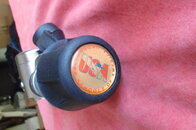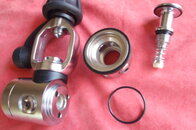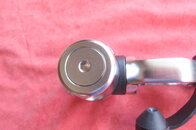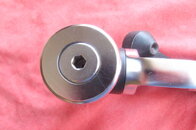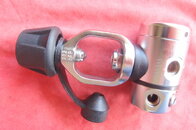spoolin01
Contributor
Just got this from eBay, represented as made by Beuchat. The only reference material I have is a 1999 service manual, and this doesn't match anything therein, though it does begin to externally resemble a version of the V10 shown in the legacy reg section, though not internally due to the turret bolt style.
It's in good shape but I can't solve a leak from the turret/LP chamber. It leaks through the seam between the turret and the body, which is sealed by a large o-ring. All sealing surfaces appear unmarred, as does the HP seat and orifice. Changing o-rings doesn't make a difference, either the turret ring or those sealing the HP chamber The leak is slow, and drops as IP is lowered via the adjusting cap. IP is <<140, with the adjusting cap flush with the diaphragm chamber end cap, and the leak persists even with IP well under 100. I'm thinking those observations point to failed sealing of LP pressure at the turret/body seam, not over-pressurization of the LP chamber.
With the "original" or a replacement turret o-ring in place, the turret swivels with about the resistance of other turret regs I've handled, whether pressurized or not, but I suppose it's possible the "original" o-ring was a replacement with under-sized cross-section by a slight amount. It's not possible to install the next sized CS o-ring from the standard series, so something metric would have to be indicated.
Not sure what to do here - if I can't solve this I may just send it back.
It's in good shape but I can't solve a leak from the turret/LP chamber. It leaks through the seam between the turret and the body, which is sealed by a large o-ring. All sealing surfaces appear unmarred, as does the HP seat and orifice. Changing o-rings doesn't make a difference, either the turret ring or those sealing the HP chamber The leak is slow, and drops as IP is lowered via the adjusting cap. IP is <<140, with the adjusting cap flush with the diaphragm chamber end cap, and the leak persists even with IP well under 100. I'm thinking those observations point to failed sealing of LP pressure at the turret/body seam, not over-pressurization of the LP chamber.
With the "original" or a replacement turret o-ring in place, the turret swivels with about the resistance of other turret regs I've handled, whether pressurized or not, but I suppose it's possible the "original" o-ring was a replacement with under-sized cross-section by a slight amount. It's not possible to install the next sized CS o-ring from the standard series, so something metric would have to be indicated.
Not sure what to do here - if I can't solve this I may just send it back.




